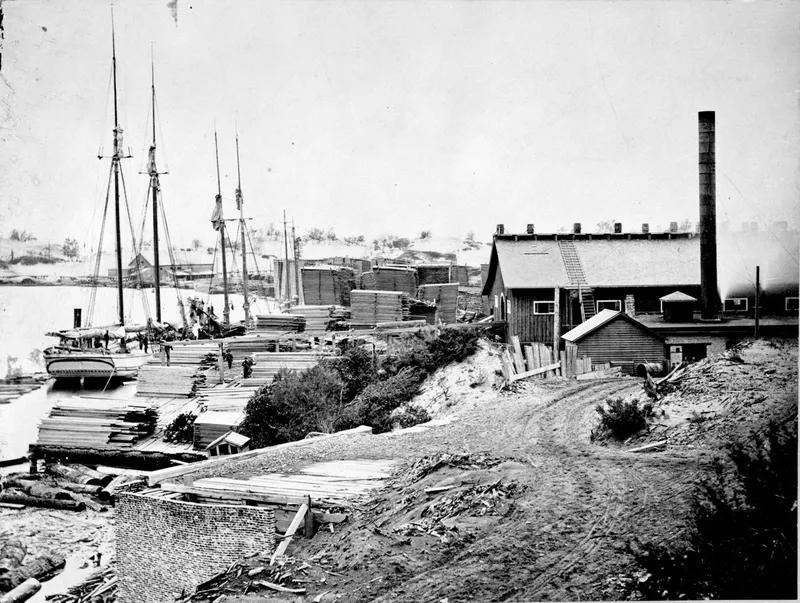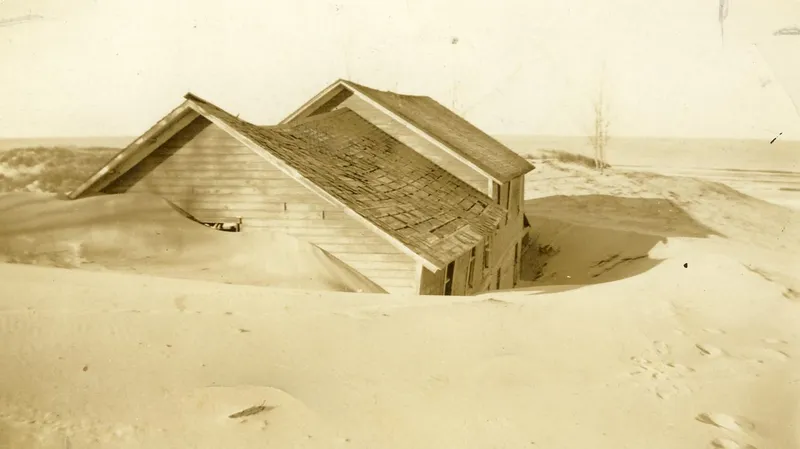

Singapore serves as a symbol of the balance between ambition and appreciation. It isn’t just a mere memory of loss; it’s one of renewal.
The dunes that swallowed the town gave rise to something: a landscape that humbles us, grounds us, and calls us to remember where we came from—and that’s worth protecting.
And this is what’s at the heart of Americans: the innate desire to flourish. To reach for something more. Something beyond ourselves.
We’re wired to do better, to achieve the next best thing, to honor our God with the talents we’ve received. Singapore was a testament to that very spirit—a town born from vision and hard work.
But when we get too far ahead of ourselves, sometimes God pulls us back in. He reminds us of what really matters—taking time to appreciate what we’ve been given and be present where we’re at.
Singapore Was Dreamt to Be the Next Hub
The founder of the town, Oshea Wilder, was a New York land speculator who aimed to establish it as a port city. He hoped to create a bustling environment where life thrived. It was supposed to be a close competitor to other port cities like Chicago, just down the lakeshore.
It was a lumbering town, known for its mills. There were available trees all around. The trees became their industry. The town grew rapidly. It had three mills, a few hotels, stores, and even its own bank. (Fun fact, these were called “wildcat banks” because they would spring up, operate for a while, take the money, and disappear.)
Other investors were interested in the town, too. They hoped it would become a bustling hub for travelers. Unfortunately, though, the town only had about twenty or so buildings before it was ravaged by a devastating fire in 1871 that burned all the way through Holland.
Which is kind of ironic seeing most of the trees in the area were gone. The townspeople had completely deforested the perceived surplus. They were forced to close down their main mill in 1875.
There were no more trees. So what now?
The industry that drove the town into an economic boom perished. There were no more jobs. Most of the mills relocated to other places such as St. Ignace and Mackinac.
The town’s residents were losing hope for its future; what aspired to be a bustling hub had turned into a mere pass through.

Then Came the Sands
With little progress to the town, the area’s sand dunes had far fewer boundaries to compete with.
As time continued, people moved out of Singapore. And the sand slowly moved in.
One local legend depicts a resident who refused to leave his home despite the pile up of sand. He remained at his residence until the sand filled the entirety of his home. For a while, he used the upstairs window to move in and out of his house. He stayed until the sand eventually closed that access point.
Some buildings were relocated to avoid being buried. They were placed on rafts and sent through the Kalamazoo River to other towns like Saugatuck. A few buildings still serve as a bookstore or an art gallery on Butler Street. Some are even houses tucked away in the surrounding neighborhoods.
Some buildings were treated as salvage. Some were just left to be buried.
It’s uncertain how much of Singapore remains under the sand. Because of the nature of sand, the buildings would be well-preserved today if one were to dig them up.
Because of the constant shift of sand, there have been periods of time where buildings and artifacts are visible to the naked eye. Over the years, the shifting has occasionally revealed glimpses of rooftops—fleeting reminders of a once-thriving town.

You Can’t See It on a Map Anymore
The town of Singapore is considerably unknown. Buried and deserted long ago, it’s become a lost relic—an example of human ambition and divine reminder. The past never really vanishes; it just settles beneath the surface, waiting to be rediscovered.
And when we rediscover stories such as Singapore, Michigan, we uncover more than just history—we uncover new perspectives.
It’s not inherently wrong to aspire or to build up; it’s in our American nature to dream.
The town was meant to be the next Chicago. It was meant to be a bustling hub, a port city alive with commerce. It was meant to have streets filled with shops, and mills buzzing with work.
For a moment, it was all of that—a place built on vision, grit, and faith in what could be.
But now it ceases to exist. But why?
Why couldn’t Singapore, Michigan flourish? What kept it from becoming the next bustling hub?
Could it have remained a humble town and continued to exist today? But something happened. We will never understand the reason. But we can theorize. It’s implied that some sort of greed was involved.
So perhaps Singapore, Michigan is a reminder that ambition must walk hand-in-hand with gratitude, or else the sands will find a way to cover what we’ve forgotten to cherish: to simply appreciate what we have and where we’re at.
Sierra Ozolins is a West Michigan native, currently a student at Hope College. As an athlete, she is passionate about fitness—from running to weightlifting. With a interest for politics and lifestyle, she is intrigued how local culture, community, and everyday events shape the world around her—often with an iced coffee in hand and her dog by her side.